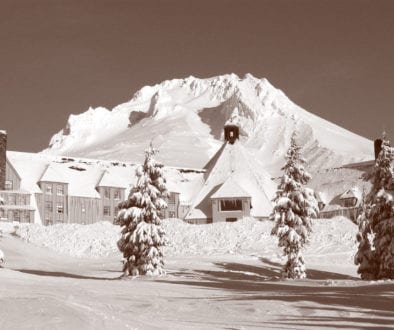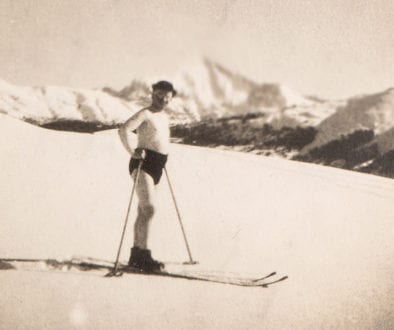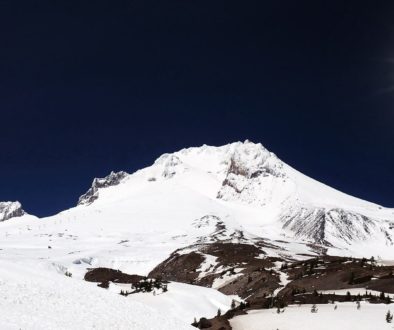Trail Skiing on Mount Hood – A Long Standing Tradition
TRAIL SKIING ON Mount HOOD
A LONG STANDING TRADITION
By Lloyd Musser
Ask any Mt. Hood skier over the age of 25 to recall a memorable skiing event on Mt. Hood and they likely will recall fond memories of skiing the Glade Trail. Should the skier be older than 50, they might also recall skiing the Alpine, Cascade, Mazama or West Leg ski trails. The real old timers may reminisce about skiing the Blossom Trail. Downhill skiing from Timberline to the village of Government Camp has been a popular activity for over 100 years. It all began when the Mazamas made that first ski trip to Mount Hood in 1900, and continues today, although on a limited, unsanctioned basis.
The Blossom Ski Trail evolved from the hiking trail that followed natural openings from Government Camp to the summit of Mt. Hood. Judge Blossom, in 1888, opened a wagon road along this route to his Camp Blossom, located near the site of Timberline Lodge. Timberline Cabin, constructed in 1916, by the Forest Service as an administrative site, was used as a bunkhouse by hardy skiers who loved to hike up to this area, ski around the openings at the timberline and stay overnight in the cabin. This form of skiing was so popular that the Mazamas convinced the Forest Service to build a winter trail from Twin Bridges to Paradise Park, where skiers could ski in the open glades at the timberline.
Detailed plans by the Forest Service for the construction and development of Timberline Lodge in 1936 indicated that access to the lodge would be by bus from Government Camp. Skiers could return to their cars via the new ski trails to be constructed. Alpine Trail, the first of the proposed trails was completed in December 1936, with its terminus at Summit Ski Area. Glade Trail followed some of the old Blossom Trail, and used the open glades to reach the core of Government Camp. Trail skiing was so popular that as many a 15 buses worked on weekends transporting skiers back to Timberline so they could ski the 3.5 mile/ 2000 foot vertical drop trail several times in a day.
Mondays were often a good time for local residents to ski the trails. If the snow was good, some people would skip work (or like Mary Ellen Loveland, skip high school), hop the Timberline Taxi and ski the Glade Trail. One local state highway worker called in sick on a Monday, and got a few days off without pay, when it was learned he was skiing all day. Local Forest Service rangers also joined the Monday outings, with the rational they needed to check the trail conditions. Skiing the trail by moonlight was another local tradition. The only problem was at least two skiers needed to be designated drivers, so they could retrieve the cars from Timberline.
Night time ski trail runs were not always for pleasure. The most vivid trail skiing memory Keith and Barbara Petire have involves running a ski patrol toboggan, loaded with an injured skier, in the dark. The cutoff between Alpine and Glade was called the corkscrew and full of washboards. Ski Patrollers guided the toboggan by straddling it and hanging on to the frame. It was a little painful when you met the toboggan coming up between your legs as you were going over the washboards.
The number of injured skiers on the trail system was of continuing concern to the Forest Service and Ski Patrol. Skier use and injuries reached a very high level in the 60’s. Ski schools, safer equipment and ski area snow grooming had lowered the number of serious injuries in the ski areas. However, ski injuries on the trails continued to be a persistent problem, caused by Portland neophytes attempting to ski on the cheap. Many tired to take advantage of this free skiing by borrowing some old skis; father would drive the group to Timberline and send his children down the trail with outdated equipment and no concept of skiing techniques. Sometimes there were so many injured skiers on the trail, that the ski patrol would load two skiers on the same rescue toboggan.
The number of the ski accidents on the Glade Trail dropped drastically when Lou Russell started roaming the trail in the early 1960’s. Using a Tucker Sno-Cat, Lou and his family packed the trail for over 20 years, as a hobby. Lou would pick up the novice or injured skiers and give them a Sno-Cat ride and gentle lecture on the merits of skiing without proper equipment and instruction.
Perhaps the most unique skiing experience on Mt. Hood during this period was the SWEEP. At the end of the day, the Forest Service Snow Rangers and Ski Patrol needed to make sure no skiers were left in peril along the trail. After waiting an appropriate time (in the Blue-Ox bar) the Sweep team would ride the Magic Mile chair lift or hitch a Sno-Cat ride with Lou to the Silcox Hut area. There the crew would wait until all the other skiers were out of sight. The crew would push off in a tuck for the non-stop run to Government Camp. The first Sweeper to break out of a tuck was the loser and expected to buy the first round at the Ratskeller. The Ratskeller also served as the terminus for the most famous, or infamous, Mt. Hood ski race. The annual Kandabeer Ski Race, sponsored by Schnee Vogeli Ski Club, was a timed race from Timberline Lodge to Government Camp. The ribald tricks and chicanery associated with this ski race are legendary. Downhill trail skiing today is not a very popular activity. The trail is not groomed. Trees and brush are slowly encroaching on the clearing. The trail makers are all gone. A few adventurous snow boarders know where the trails are and use them when snow conditions are favorable. Telemark and crosscounty skiers use portions of the trails. The Timberline Taxi is but a memory and a line in a local song. Trail skiing thrills have been replaced with high-speed quad chairlifts, halfpipes, terrain parks and freestyle aerials.
Lloyd Musser was a Forest Service Snow Ranger in the 60’s, serves on the museum
board and volunteers as museum curator.




